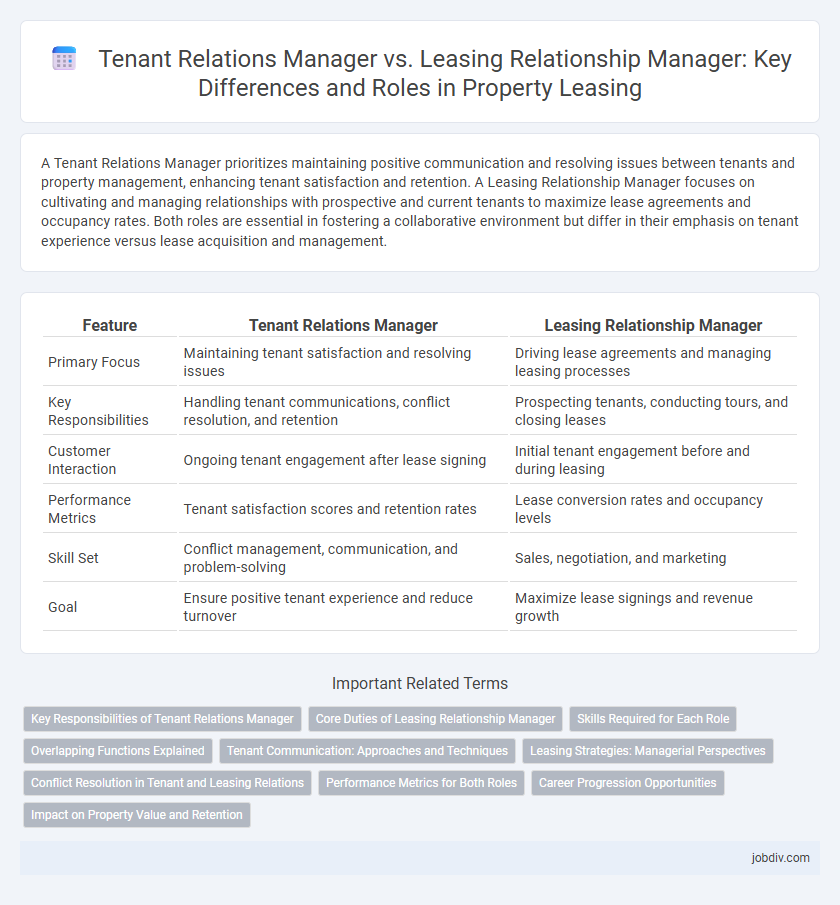A Tenant Relations Manager prioritizes maintaining positive communication and resolving issues between tenants and property management, enhancing tenant satisfaction and retention. A Leasing Relationship Manager focuses on cultivating and managing relationships with prospective and current tenants to maximize lease agreements and occupancy rates. Both roles are essential in fostering a collaborative environment but differ in their emphasis on tenant experience versus lease acquisition and management.
Table of Comparison
| Feature | Tenant Relations Manager | Leasing Relationship Manager |
|---|---|---|
| Primary Focus | Maintaining tenant satisfaction and resolving issues | Driving lease agreements and managing leasing processes |
| Key Responsibilities | Handling tenant communications, conflict resolution, and retention | Prospecting tenants, conducting tours, and closing leases |
| Customer Interaction | Ongoing tenant engagement after lease signing | Initial tenant engagement before and during leasing |
| Performance Metrics | Tenant satisfaction scores and retention rates | Lease conversion rates and occupancy levels |
| Skill Set | Conflict management, communication, and problem-solving | Sales, negotiation, and marketing |
| Goal | Ensure positive tenant experience and reduce turnover | Maximize lease signings and revenue growth |
Key Responsibilities of Tenant Relations Manager
Tenant Relations Managers oversee communication between tenants and property management, ensuring tenant satisfaction through prompt resolution of maintenance issues and lease inquiries. They coordinate tenant onboarding and move-in processes, enforce lease agreements, and manage conflict resolution to maintain positive community relations. Their role emphasizes enhancing tenant retention and fostering a seamless rental experience by addressing tenant needs proactively.
Core Duties of Leasing Relationship Manager
Leasing Relationship Managers primarily focus on fostering long-term tenant retention by managing lease agreements, resolving tenant issues, and ensuring compliance with leasing policies. They act as a liaison between tenants and property owners, coordinating maintenance requests and facilitating clear communication to enhance tenant satisfaction. Core duties include lease negotiation, monitoring tenant occupancy, and implementing strategies to optimize tenant engagement and lease renewals.
Skills Required for Each Role
A Tenant Relations Manager requires strong interpersonal communication skills, conflict resolution expertise, and deep knowledge of tenant rights and property management policies to effectively address tenant concerns and maintain positive community relations. In contrast, a Leasing Relationship Manager must possess advanced sales acumen, negotiation skills, and proficiency in market analysis to drive lease agreements and foster long-term tenant engagement. Both roles demand excellent organizational abilities and customer service orientation, but the Tenant Relations Manager leans more towards dispute management, while the Leasing Relationship Manager focuses on maximizing occupancy and lease revenue.
Overlapping Functions Explained
Tenant Relations Managers and Leasing Relationship Managers both focus on fostering positive connections between property owners and tenants, emphasizing communication and issue resolution. Tenant Relations Managers primarily handle tenant satisfaction, conflict management, and community engagement, while Leasing Relationship Managers concentrate on lease negotiations, renewals, and maintaining long-term tenant retention. Their overlapping functions include tenant communication, relationship-building, and facilitating seamless leasing processes to enhance tenant experience and retention rates.
Tenant Communication: Approaches and Techniques
Tenant Relations Managers prioritize proactive tenant communication through personalized outreach, conflict resolution, and feedback collection to enhance tenant satisfaction and retention. Leasing Relationship Managers focus on building rapport during the leasing process by employing targeted marketing, personalized property tours, and follow-up communications to streamline lease agreements and attract prospective tenants. Both roles utilize digital communication platforms and data analytics to tailor interactions but differ in timing and emphasis: Tenant Relations Managers engage post-lease, while Leasing Relationship Managers concentrate on pre-lease engagement.
Leasing Strategies: Managerial Perspectives
Tenant Relations Managers focus on fostering long-term tenant satisfaction by implementing personalized service strategies and resolving conflicts efficiently, which enhances tenant retention rates. Leasing Relationship Managers prioritize optimizing leasing strategies through data-driven market analysis and negotiation tactics to maximize occupancy and revenue. Both managerial roles require strategic collaboration to balance tenant engagement with financial performance in competitive real estate markets.
Conflict Resolution in Tenant and Leasing Relations
Tenant Relations Managers specialize in conflict resolution by directly addressing tenant concerns, facilitating communication, and ensuring lease compliance to maintain tenant satisfaction. Leasing Relationship Managers focus on balancing tenant needs with property owner interests, mediating disputes, and negotiating lease terms to foster long-term leasing relationships. Both roles require strong interpersonal skills and strategic problem-solving to prevent conflicts from escalating and ensure smooth tenancy experiences.
Performance Metrics for Both Roles
Tenant Relations Managers are evaluated primarily on tenant satisfaction scores, retention rates, and the speed of resolving tenant complaints, ensuring a high level of community engagement and loyalty. Leasing Relationship Managers focus on metrics such as lease renewal rates, new lease acquisition numbers, and occupancy percentage, driving revenue growth and portfolio performance. Both roles demand strong communication skills but differ as Tenant Relations Managers prioritize tenant experience while Leasing Relationship Managers emphasize leasing volume and financial outcomes.
Career Progression Opportunities
Tenant Relations Managers specialize in maintaining positive interactions and resolving tenant issues, often leading to roles in property management or director-level positions overseeing tenant experience. Leasing Relationship Managers focus on driving occupancy and lease agreements, which can advance into senior leasing strategy roles or commercial real estate development. Career progression in both paths benefits from strong communication skills, industry knowledge, and leadership capabilities, with potential transitions between tenant-focused and lease-focused management roles depending on organizational needs.
Impact on Property Value and Retention
A Tenant Relations Manager directly enhances tenant satisfaction through proactive communication and swift issue resolution, leading to higher retention rates and stable rental income, which positively impacts property value. In contrast, a Leasing Relationship Manager focuses on securing new leases and optimizing lease terms, driving occupancy rates and revenue growth that contribute to increased property valuation. Both roles are critical, but the Tenant Relations Manager's influence on tenant retention often results in longer-term property value stability.
Tenant Relations Manager vs Leasing Relationship Manager Infographic

 jobdiv.com
jobdiv.com